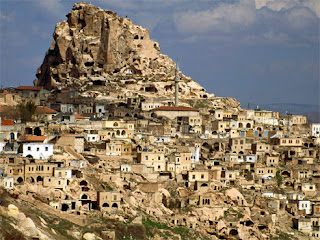1. Petra, Jordan


City of Petra in Jordan is known as the setting of the film, Indiana Jones and the Last Crusade. It is also one of the 7 wonders of the world, and it's easy to see why the architecture is among the most sophisticated ever seen. Built into the slope of Mount Hor, Petra developed during Roman times, but it is not known to the western world until 1812 when it was discovered by a Swiss explorer, Johann Ludwig Burckhardt. More than 800 individual monuments can be seen in Petra, including tombs, baths, temples and burial chambers
2. Al-Hijr, Saudi Arabia


Among the most famous sites of Saudi Arabia is Al Hijr architecture, also known as Madain Saleh. The front of the residence at Al Hijr was carved in sandstone mountain sometime in the second millennium BC. Al Hijr - which literally means 'rocky place' - believed to have been inhabited by the Nabataeans and Thamud. It features water wells, preserved monumental tombs, inscriptions and cave drawings.
3. Rock-hewn Churches of Lalibela, Ethiopia

The most amazing structures carved out of the rock are the churches of Lalibela, Ethiopia.11 rock hewn churches have each carved from a single block of granite with a roof at ground level. 12th-century King Lalibela commissioned churches with the goal of creating a New Jerusalem for those who could not make the pilgrimage to the original city. Each church was created by a wide moat carved on all four sides of the stone and then painstakingly chiseling out the interior. The biggest of them stand as high as 40 meters.
4. Abu Simbel Nubian Monuments, Egypt


Four colossal statues of the ancient Egyptian Pharaoh Ramses II guard the door of Abu Simbel, a temple cut out of the sandstone cliffs above the River Nile. Commissioned by Ramesses himself, the temple faces east so that twice a year, the sun reaches into the innermost sanctuary, illuminating the statue of Ptah, Amun-Re, Ramesses II and Re-Horakhty. Complex removed entirely from its original setting in 1960 to avoid flooding when Lake Nasser was created.
5. Goa Gajah, Elephant Cave Temple, Bali

Gojah goa, Goa Gajah, Bali is one of the sites of the most historically significant. Cave seems mostly destroyed by natural disasters while, and go undetected for centuries until a team of Dutch archaeologists discovered it in 1923. Thought has been built in the 11th century, Cave Gojah features sculptures influenced by Hinduism and Buddhism and contains secret meditation room for priests or hermits. Two traditional bathing pools outside the cave containing water is said to have magical properties.
6. Cappadocia Cave Houses, Turkey


Cappadocia is one of 73 provinces as the Republic of Turkey, and has one of the most bizarre and interesting in the world. Soil, rock dwarf features tufa rock formations' strange volcanic referred to as' Fairy Chimneys' and cities underground complex and deducted from the buildings' tuff 'soft. Many of them are the church, with columns and arches decorate the stone face of a declared natural stone.
7. Ancient Rock City of Matera, Italy

In the ancient rock city of Matera in southwestern Italy, people living in the exact same house that their ancestors did not 9,000 years ago. Matera was created from a rocky ravine and natural caves are many in the area - called 'Sassi di Matera' - was the first home of the Neolithic in the region. Creating a labyrinth cave house, and it was almost impossible to distinguish the natural rock formations of ancient architecture. The houses seemed to grow out of the rock in an organic way, creating a bit of attraction of what is in the middle of the 20th century a ghost town. Matera is mainly the setting for Mel Gibson's movie "The Passion of the Christ '.



